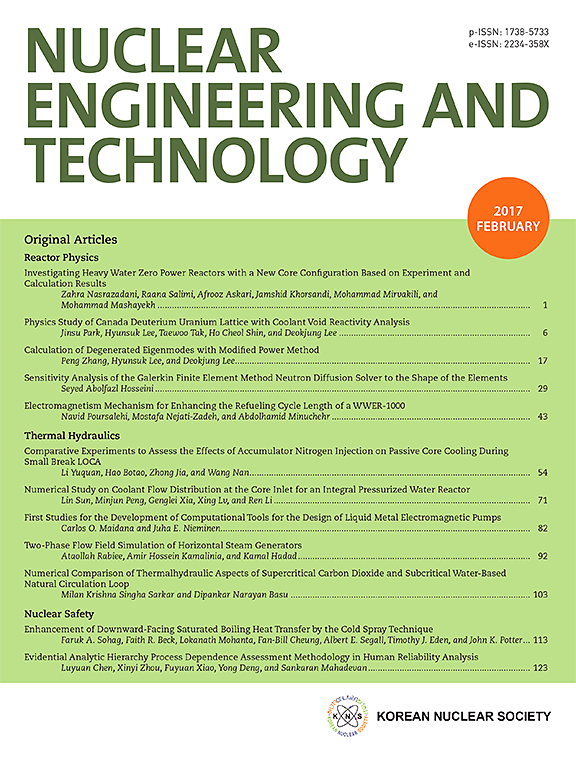为压水堆中间断口失冷事故编制现象识别和排序表(PIRT)
IF 2.6
3区 工程技术
Q1 NUCLEAR SCIENCE & TECHNOLOGY
引用次数: 0
摘要
最近出现的安全问题,如包壳氧化和燃料碎裂、迁移和分散(FFRD),使失去冷却剂事故(LOCA)的验收标准更难满足。为了获得足够的安全裕度和更经济地使用核电站,目前正在考虑对韩国运行中压水堆的失效冷却剂事故进行重新分类,将大破损失效冷却剂事故(LBLOCA)排除在设计基础事故(DBA)之外。因此,中间断裂 LOCA (IBLOCA) 可能会成为 LOCA 分析中关注的极限断裂尺寸。要完成 LOCA 分类改革,广泛了解 IBLOCA 至关重要,而且应确认安全分析代码的适用性。为此,开发了 IBLOCA PIRT。在开发 IBLOCA PIRT 时,组织了 PIRT 小组,并采用了 Wilson 和 Boyack(1998 年)制定的 PIRT 开发一般流程。根据使用安全和性能分析代码(SPACE)进行的 IBLOCA 分析,PIRT 小组定义了 IBLOCA 期间的时间阶段、系统、组件和可能出现的现象。对于所有可能出现的现象,通过 PIRT 小组成员之间的讨论,确定了每个组件和每个阶段的相对重要性和知识水平。对于重要性相对较高的现象,还制定了代码验证矩阵。IBLOCA PIRT 的结果将用于改进 IBLOCA 应用的 SPACE 代码,并解决未来的监管问题。本文章由计算机程序翻译,如有差异,请以英文原文为准。
Development of a phenomena identification and ranking table (PIRT) for intermediate break loss-of-coolant accident in PWRs
Recent safety issues such as cladding oxidation and fuel fragmentation, relocation and dispersal (FFRD) make the loss-of-coolant accident (LOCA) acceptance criteria more difficult to be satisfied. To obtain the adequate safety margin and more economical use of the nuclear power plant, re-classification of LOCAs for Korean operating PWRs is now under consideration to exclude the large break LOCA (LBLOCA) from the design basis accidents (DBAs). Therefore, the intermediate break LOCA (IBLOCA) might become the limiting break size of concern in the LOCA analysis. To accomplish this reform of LOCA classification, an extensive understanding of IBLOCA is crucial, and the applicability of safety analysis code should be confirmed. For this purpose, IBLOCA PIRT was developed. The PIRT panel was organized and the general process of the PIRT development established by Wilson and Boyack (1998) was adopted to develop the IBLOCA PIRT. Based on IBLOCA analyses using the safety and performance analyzing code (SPACE), the PIRT panel defined the temporal phases, systems, components and possible phenomena during an IBLOCA. For all possible phenomena, the relative importance and the knowledge level were determined for each component and each phase via discussions among PIRT panel members. For phenomena having relatively high importance, a code validation matrix was also developed. The results of the IBLOCA PIRT will be used to improve the SPACE code for IBLOCA application and resolve future regulatory issues.
求助全文
通过发布文献求助,成功后即可免费获取论文全文。
去求助
来源期刊

Nuclear Engineering and Technology
工程技术-核科学技术
CiteScore
4.80
自引率
7.40%
发文量
431
审稿时长
3.5 months
期刊介绍:
Nuclear Engineering and Technology (NET), an international journal of the Korean Nuclear Society (KNS), publishes peer-reviewed papers on original research, ideas and developments in all areas of the field of nuclear science and technology. NET bimonthly publishes original articles, reviews, and technical notes. The journal is listed in the Science Citation Index Expanded (SCIE) of Thomson Reuters.
NET covers all fields for peaceful utilization of nuclear energy and radiation as follows:
1) Reactor Physics
2) Thermal Hydraulics
3) Nuclear Safety
4) Nuclear I&C
5) Nuclear Physics, Fusion, and Laser Technology
6) Nuclear Fuel Cycle and Radioactive Waste Management
7) Nuclear Fuel and Reactor Materials
8) Radiation Application
9) Radiation Protection
10) Nuclear Structural Analysis and Plant Management & Maintenance
11) Nuclear Policy, Economics, and Human Resource Development
 求助内容:
求助内容: 应助结果提醒方式:
应助结果提醒方式:


